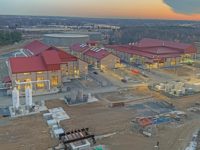Seattle sewer lines installed in the early- to mid-20th century simply can’t handle the up to 70 million gallons of polluted stormwater that flows into the Duwamish River. And as Seattle continues to grow and impervious surfaces create additional runoff, the combined sewer-wastewater systems that fill much of the Seattle area exceed the capacity of existing wastewater treatment facilities.
A $262-million project near Seattle’s Georgetown neighborhood will begin to change that reality.
The Georgetown Wet Weather Treatment Station in King County, Wash., will handle excess stormwater and wastewater—generally 90% stormwater and 10% sewage—in times of need. The conveyance and outfall portions are nearly complete and the treatment station, the largest portion of the project, has passed the halfway point.
The Georgetown project includes ballasted sedimentation as a treatment process, which has created a unique design for the facility. The sedimentation basins were moved above grade to address concerns about flooding.
Flatiron West Inc. is constructing the station. Virgil Curtis, Flatiron project manager, says structural concrete is 85% complete and structural steel is in the process of being erected with architectural finishes following later this year.
The project will allow for up to 3 in. of settlement. Bruce Kessler, deputy division director for King County Wastewater Treatment Division, says they plan to build basins, fill the tanks and monitor them for 30 days to ensure the project stays within the allowed settlement. That test should happen this summer.
Chris Mack, King County Wastewater Treatment Division construction unit manager, says the settlement testing offers a key milestone because once settlement is achieved, final piping connections and mechanical equipment can be set.
“Factory testing of mechanical and electrical equipment and receipt of major mechanical equipment has commenced and will continue over the next several months,” Curtis says, “with installation of mechanical and electrical gear beginning this summer.”
Following that construction milestone, the Georgetown project will continue to move toward a mid-2022 completion date, on time and on budget. The outfall portion of the contract, performed by Pacific Pile & Marine, has finished and the conveyance, executed by James W. Fowler Co., is scheduled for completion in December 2020.
Kessler says soil conditions made those two projects trickier than anticipated, causing delays but without an impact on the overall schedule. The area near the plant is in a historic floodplain, and rail lines and roadways were often supported by pilings. “The piles are still in place and there is no historical record on where those are,” Kessler says. “Excavating in those areas for conveyance and outfall, we ran into a lot of unknown site conditions.” In one circumstance, crews needed to bring in larger equipment to clear rubble.
The treatment station’s cleaned water will flow through underground pipes to enter the Duwamish River underneath the State Route 509 Bridge. The new outfall structure underneath the bridge will connect to the station.
Another key portion of the project comes in the form of the equalization chamber, a 102-ft-dia shaft with 30-ft concrete plus. The area was excavated in the wet — a standard technique — based on the proximity to the river and moved forward without hurdles.
King County’s Wastewater Treatment Division conducted community outreach throughout the design phase to ensure the $262 million project reflects local character. The sustainable design includes a green roof and cisterns to filter and collect stormwater. New trees aim to improve air quality in an area of Seattle with one of the highest asthma rates. The station will also have space for school programs and environmental education.
Added design elements include special lights along the building to alert those nearby when the station is working; the ability to see through the fencing to the building's open design; and colored pipes to show the water’s path through the station.
Mack says the design was also meant to accommodate up to 2 ft of sea level rise over the lifespan of the facility.
The U.S. Environmental Protection Agency selected the Georgetown project as one of a dozen nationwide to qualify for low-interest loans through its Water Infrastructure Finance and Innovation Act Program. King County’s project qualifies for $134.5 million in loan funding.
The Georgetown Wet Weather Treatment Station signifies the first of eight projects that will complete King County’s four-decade work to control the combined sewer outflow that still occurs in parts of Seattle.






Post a comment to this article
Report Abusive Comment